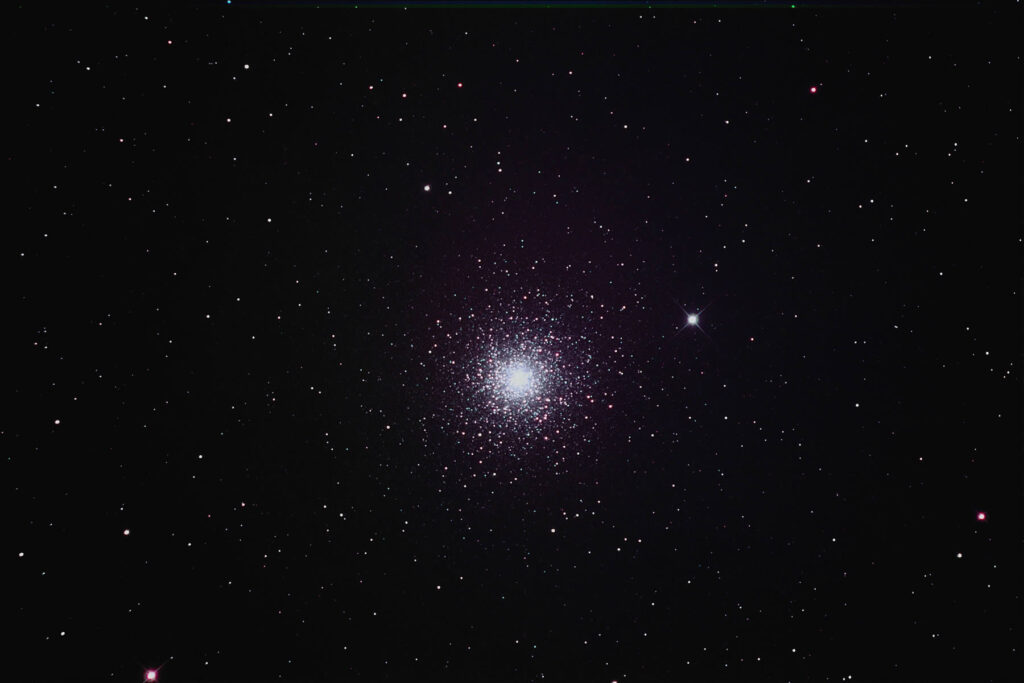M15 is one of the most impressive examples of a globular star cluster in our Milky Way galaxy. Globular clusters are compact groups of several hundred thousand to a million or so stars that are gravitationally linked. Nearly 150 such clusters have been detected in our galaxy, but the actual number must be at least twice this number because we cannot detect clusters on the opposite side of the galactic center.
In the 1930s astronomer Harlow Shapley was able to prove that all visible globular star clusters are located in the galactic halo, far from the galactic center, and form an inverted "bowl." He deduced, correctly, that the center of this bowl was in fact the center of our galaxy. This proved conclusively that the Earth was not the center of the galaxy, but rather is located near the edge of the galaxy on one of the spiral arms.
Easily seen high overhead in the northern hemisphere as a small, circular blur in binoculars during the summer months, M15 is resolved into a swarm of stars in moderately-sized amateur telescopes, revealing its true nature. In fact, this cluster contains perhaps a half a million stars, crowded into an area that is about 210 light years in diameter.
Would the sky appear to be filled with bright stars like our Sun on a planet in this cluster? A spherical cluster with a radius of 210 light years would have a total volume of 40 million cubic light years, which yields an average separation between stars of 4 light years (about the distance of our Sun to the nearest star) given a total population of 500,000 stars. But this is misleading, since the density of stars increases nearer the center of the cluster. Detailed images of M15 taken by the Hubble Space Telescope in 1994 show 30,000 stars in the central 22 light years of the cluster. This would yield a stellar density (average distance between stars) of about 1.5 light years, or about a third of the distance from our Sun to the nearest known star, Proxima Centauri. Our Sun, if it were 1.5 light years away, would shine at a magnitude (brightness) of -1.9, or about the same brightness as the star Sirius, the brightest star in the sky from planet Earth (other than the Sun). So, from a planet near the center of this cluster, the sky would be filled with glittering, bright stars, but they would appear as bright stars, not as numerous "Suns."
The actual mass of the cluster has been computed to be 350,000 solar masses, but, since our Sun is a comparatively large star, the actual number of stars in M15 must exceed this number. The bright star to the right of the cluster is a foreground star, HD204712, a mere 223 light years away.
Like us, M15 is orbiting the center of our galaxy, but is on another spiral arm some 35,000 light years away in the constellation Pegasus.
Globular Cluster M15 in Pegasus
Date Taken:March 3, 2013
Location Taken: Conditions of Location:mag 4.5 sky, FWHM 2.0
Equipment Used:14.5" Ritchey-Chretien, SBIG STL11000 CCD camera, Astrodon RGB filters, TCC, PIR, remote guide head used with Takahashi FSQ106 for autoguiding, T-Point used for polar alignment (required for each imaging session due to my portable setup)
Processing Used:15 x 300 seconds luminance, 8 x 200 seconds RGB, guided, 1x1 binning, processed in Maxim DL and Photoshop (total exposure 2.5 hours)
Distance from Location:35,000 light years
Constellation:Pegasus
Other Link:

Fascinating! The question you addressed at the end came to mind immediately upon seeing this image. However, I realized there would not be a 100 sun sunrise when you pointed out the average distance between stars of 4 light years. Still, an amazing image.
Well done. Thanks for sharing Rich.
It looks like a diamond!